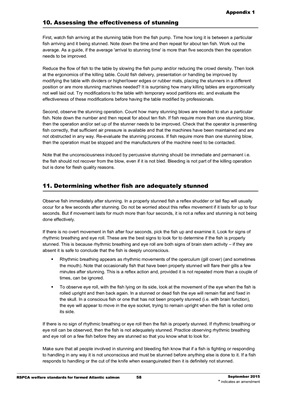
Appendix 1
RSPCA welfare standards for farmed Atlantic salmon 58 September 2015
* indicates an amendment
10. Assessing the effectiveness of stunning
First, watch fish arriving at the stunning table from the fish pump. Time how long it is between a particular
fish arriving and it being stunned. Note down the time and then repeat for about ten fish. Work out the
average. As a guide, if the average 'arrival to stunning time' is more than five seconds then the operation
needs to be improved.
Reduce the flow of fish to the table by slowing the fish pump and/or reducing the crowd density. Then look
at the ergonomics of the killing table. Could fish delivery, presentation or handling be improved by
modifying the table with dividers or higher/lower edges or rubber mats, placing the stunners in a different
position or are more stunning machines needed? It is surprising how many killing tables are ergonomically
not well laid out. Try modifications to the table with temporary wood partitions etc. and evaluate the
effectiveness of these modifications before having the table modified by professionals.
Second, observe the stunning operation. Count how many stunning blows are needed to stun a particular
fish. Note down the number and then repeat for about ten fish. If fish require more than one stunning blow,
then the operation and/or set up of the stunner needs to be improved. Check that the operator is presenting
fish correctly, that sufficient air pressure is available and that the machines have been maintained and are
not obstructed in any way. Re-evaluate the stunning process. If fish require more than one stunning blow,
then the operation must be stopped and the manufacturers of the machine need to be contacted.
Note that the unconsciousness induced by percussive stunning should be immediate and permanent i.e.
the fish should not recover from the blow, even if it is not bled. Bleeding is not part of the killing operation
but is done for flesh quality reasons.
11. Determining whether fish are adequately stunned
Observe fish immediately after stunning. In a properly stunned fish a reflex shudder or tail flap will usually
occur for a few seconds after stunning. Do not be worried about this reflex movement if it lasts for up to four
seconds. But if movement lasts for much more than four seconds, it is not a reflex and stunning is not being
done effectively.
If there is no overt movement in fish after four seconds, pick the fish up and examine it. Look for signs of
rhythmic breathing and eye roll. These are the best signs to look for to determine if the fish is properly
stunned. This is because rhythmic breathing and eye roll are both signs of brain stem activity - if they are
absent it is safe to conclude that the fish is deeply unconscious.
Rhythmic breathing appears as rhythmic movements of the operculum (gill cover) (and sometimes
the mouth). Note that occasionally fish that have been properly stunned will flare their gills a few
minutes after stunning. This is a reflex action and, provided it is not repeated more than a couple of
times, can be ignored.
To observe eye roll, with the fish lying on its side, look at the movement of the eye when the fish is
rolled upright and then back again. In a stunned or dead fish the eye will remain flat and fixed in
the skull. In a conscious fish or one that has not been properly stunned (i.e. with brain function),
the eye will appear to move in the eye socket, trying to remain upright when the fish is rolled onto
its side.
If there is no sign of rhythmic breathing or eye roll then the fish is properly stunned. If rhythmic breathing or
eye roll can be observed, then the fish is not adequately stunned. Practice observing rhythmic breathing
and eye roll on a few fish before they are stunned so that you know what to look for.
Make sure that all people involved in stunning and bleeding fish know that if a fish is fighting or responding
to handling in any way it is not unconscious and must be stunned before anything else is done to it. If a fish
responds to handling or the cut of the knife when exsanguinated then it is definitely not stunned.